您的购物车目前是空的!
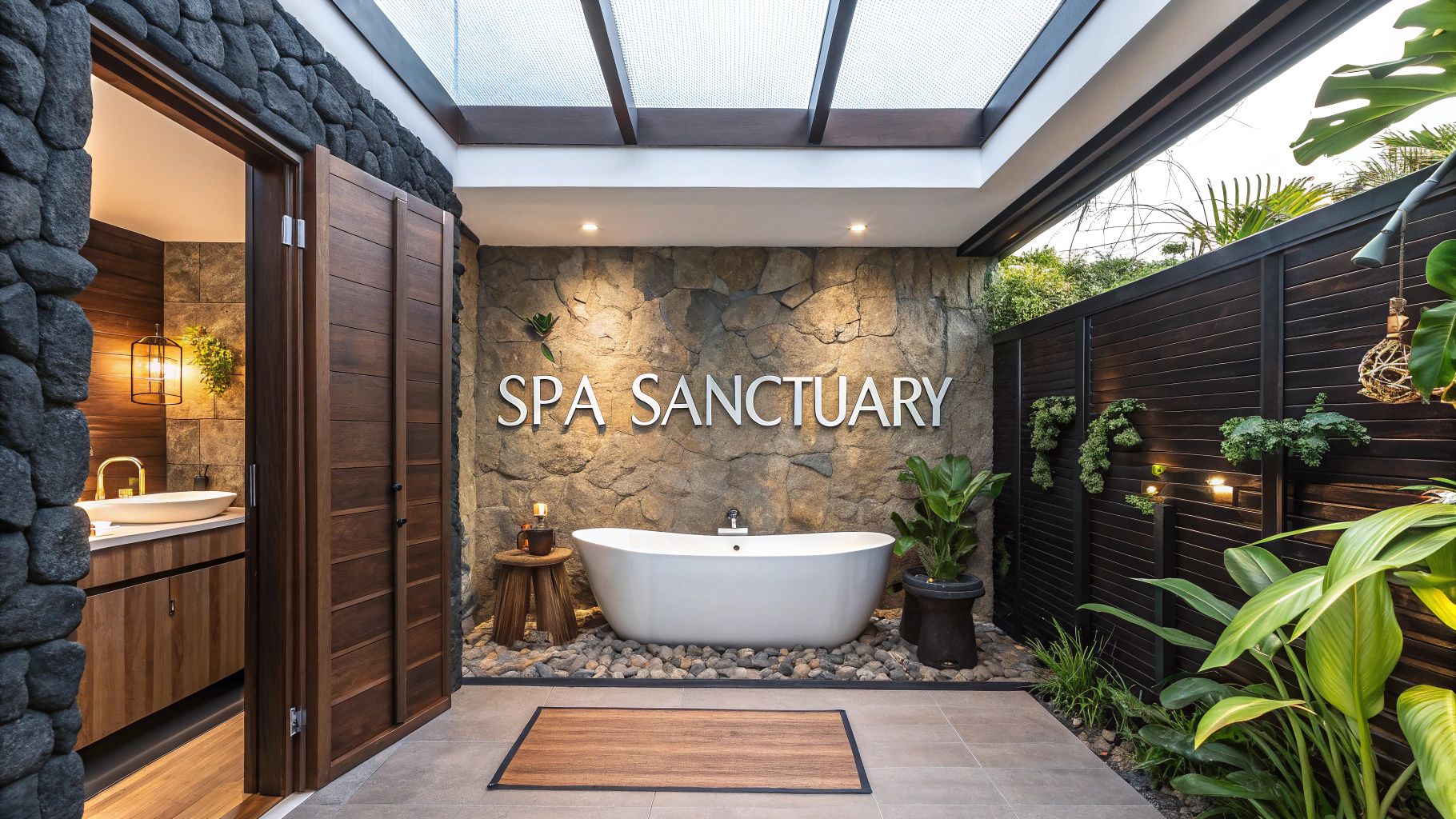
7 Incredible Spa Ideas for Bathroom Transformations in 2025
Imagine stepping out of the daily grind and into a personal sanctuary designed for ultimate relaxation and rejuvenation. A place where stress melts away, and tranquility takes over. This isn't a far-off luxury resort; it's the potential hidden within your own home. Transforming your bathroom into a spa-like retreat is more than a design trend; it's an investment in your well-being, a concept gaining significant traction in modern home design.
This guide offers actionable spa ideas for bathroom renovations, helping you create a serene escape tailored to your specific needs. From advanced hydrotherapy systems like a led shower head system to the calming influence of natural materials, we'll explore seven transformative concepts that can redefine your daily routine. As noted by industry authorities like the National Kitchen & Bath Association, wellness-focused design is a top priority for homeowners, emphasizing features that promote health and personal comfort.
We will move beyond generic suggestions to provide practical implementation details for each idea. You will discover how to integrate features like multi-sensory shower experiences, ambient chromotherapy lighting, and smart-controlled heated flooring. For those seeking the pinnacle of thermal therapy, exploring dedicated sauna options can add another profound layer of relaxation to your home spa sanctuary. Let's delve into the specific elements that can elevate your bathroom from a purely functional space to a haven of personal wellness and sophisticated style.
1. Immerse Yourself with an Advanced Rain Shower System
The cornerstone of a modern home spa is an immersive, multi-sensory shower experience. Moving beyond a standard showerhead, an advanced rain shower system transforms a daily routine into a therapeutic ritual. This upgrade centers on a large overhead rainfall showerhead, often supplemented with body jets, and a handheld spray, creating a holistic hydrotherapy environment. The goal is to simulate the soothing sensation of natural rainfall while providing targeted water massage to release tension and rejuvenate the body.
This type of system is one of the most impactful spa ideas for bathroom renovations because it directly engages the senses. High-end models can even incorporate chromotherapy (light therapy) through a led shower head system. These systems use colored lights to influence mood, from calming blues and greens to energizing reds and yellows, adding another layer of wellness to your shower. The Global Wellness Institute notes that regular hydrotherapy can significantly reduce stress and improve circulation, making this a worthwhile investment in your long-term health.
How to Implement a Luxury Shower System
Creating this experience involves more than just swapping a fixture. It requires a thoughtful approach to both plumbing and design. Companies like CRANACH specialize in integrated wellness-focused systems. Their Wellness Packages offer a complete solution, featuring large rainfall heads, multiple jets, and advanced thermostatic controls to craft your perfect shower environment safely and consistently.
Pro-Tip: A thermostatic valve is a non-negotiable component for multi-function showers. It maintains a precise water temperature, preventing dangerous spikes if water is used elsewhere in the house, a crucial safety feature confirmed by plumbing codes like the Uniform Plumbing Code (UPC).
Key Considerations for Installation
To ensure your system performs flawlessly and safely, keep these actionable tips in mind:
- Assess Water Pressure: Advanced systems with multiple outlets demand strong water pressure. A plumber can assess your home's PSI (pounds per square inch) and recommend a booster pump if necessary.
- Plan for Drainage: A high-volume shower requires a high-capacity drain to prevent water from pooling. Consider a linear drain for a sleek look and superior performance.
- Professional Installation is Crucial: Hire a certified plumber to install the complex valve systems. Correct installation is essential for safety, preventing leaks, and ensuring all functions work as intended.
- Conserve with Independent Controls: Opt for a system where the rain shower, body jets, and handheld wand can operate independently. This allows you to conserve water when a full, high-volume experience isn't needed.
2. Freestanding Soaking Tub with Aromatherapy Features
The visual and spiritual heart of many spa-inspired bathrooms is a magnificent freestanding soaking tub. Unlike standard built-in tubs, a freestanding model acts as a sculptural centerpiece, elevating the room's aesthetic from purely functional to deeply restorative. These tubs are engineered for long, comfortable soaks with ergonomic designs that support the body. Modern innovations further enhance their therapeutic value by integrating features like aromatherapy diffusers and chromotherapy lighting, transforming a simple bath into a multi-sensory wellness ritual.
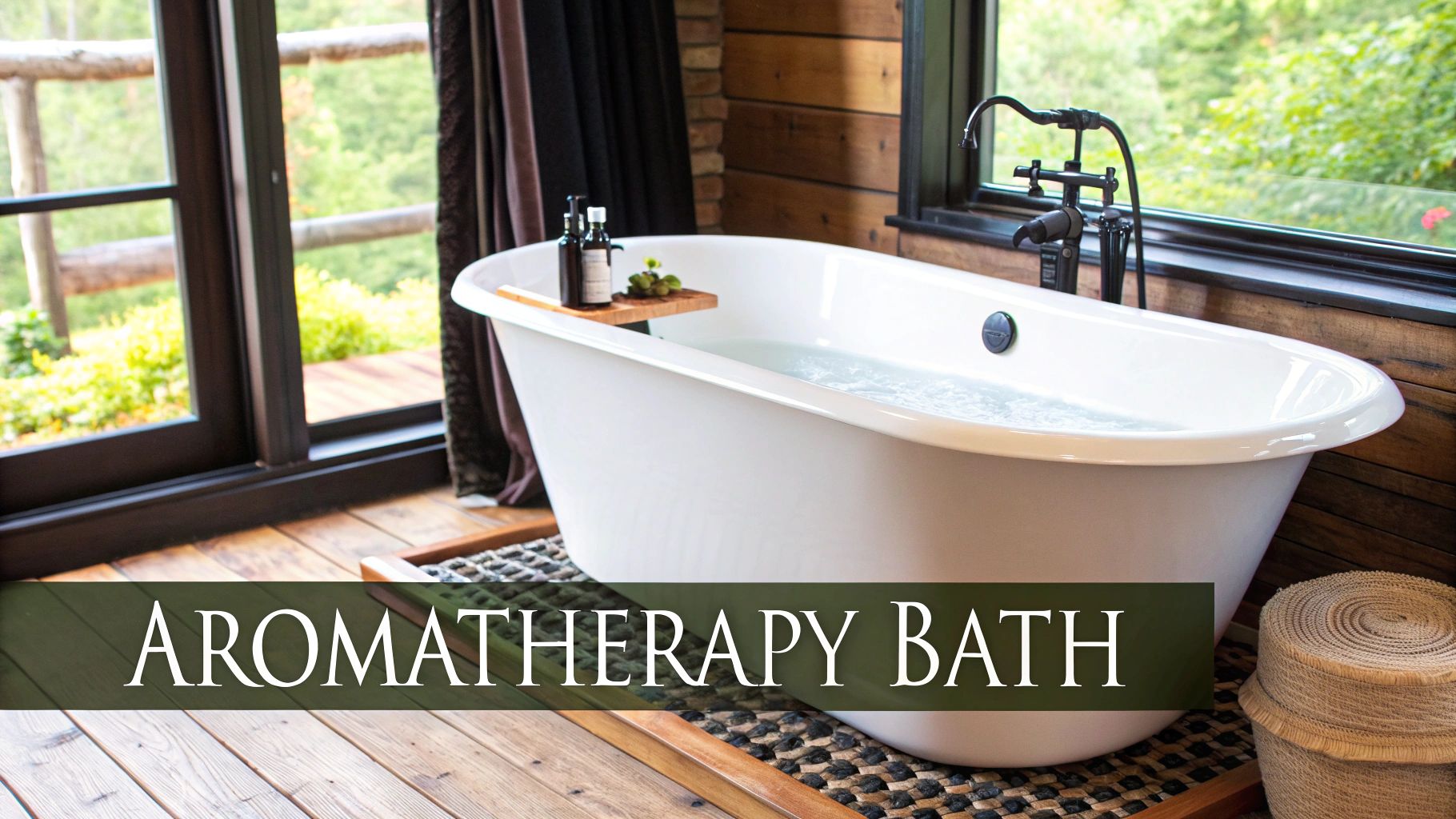
This particular upgrade is one of the most transformative spa ideas for bathroom design because it creates a dedicated space for unwinding. The practice of aromatherapy, using essential oils to promote health and well-being, is a cornerstone of spa culture. Tubs with built-in diffusers gently release scents like lavender for relaxation or eucalyptus for clarity directly into the steam and water. The National Association for Holistic Aromatherapy (NAHA) highlights the profound effect of scent on mood and stress levels, making this an integrated and effective way to deepen your relaxation.
How to Implement a Therapeutic Soaking Tub
Selecting and installing a freestanding tub requires careful planning to ensure it not only fits the space but also enhances the overall spa-like ambiance. Many manufacturers offer models that blend artistic form with therapeutic function, often incorporating advanced materials that retain heat longer for extended soaks. The goal is to create a destination within the bathroom, a focal point that invites you to slow down and de-stress.
Pro-Tip: For a truly cohesive wellness environment, pair your soaking tub experience with a complementary shower system. The sensory elements of a led shower head system can prime your body for relaxation before a soak or invigorate you after. The combination creates a complete hydrotherapy circuit within your own home.
Key Considerations for Installation
To maximize the impact and functionality of your freestanding tub, consider these actionable steps:
- Plan the Placement: Position the tub where it can be a true focal point. Near a window with a view or under a skylight can connect your bathing ritual with natural light.
- Verify Access and Support: Freestanding tubs, especially those made from solid surface materials or stone, are heavy. Ensure your floor structure can support the weight and that doorways and hallways are wide enough for delivery.
- Consider Floor-Mounted Fillers: These fixtures complete the elegant look but require plumbing to be run through the floor. Plan for this during the early stages of a renovation with your plumber.
- Incorporate Comfort Elements: Enhance the area around the tub for a complete experience. Install heated flooring beneath, add a small waterproof side table for a book or tea, and ensure plush towels are within easy reach.
3. Heated Floors with Smart Temperature Control
One of the most subtle yet profound luxuries in a spa is the gentle, consistent warmth underfoot. Radiant floor heating brings this sophisticated comfort into your home, eliminating the shock of cold tiles and creating an environment of continuous coziness. This system works by installing electric mats or hydronic tubes beneath the flooring, which radiate heat upward, warming the entire room evenly and efficiently from the ground up. It’s a foundational element for crafting an authentic spa-like atmosphere.
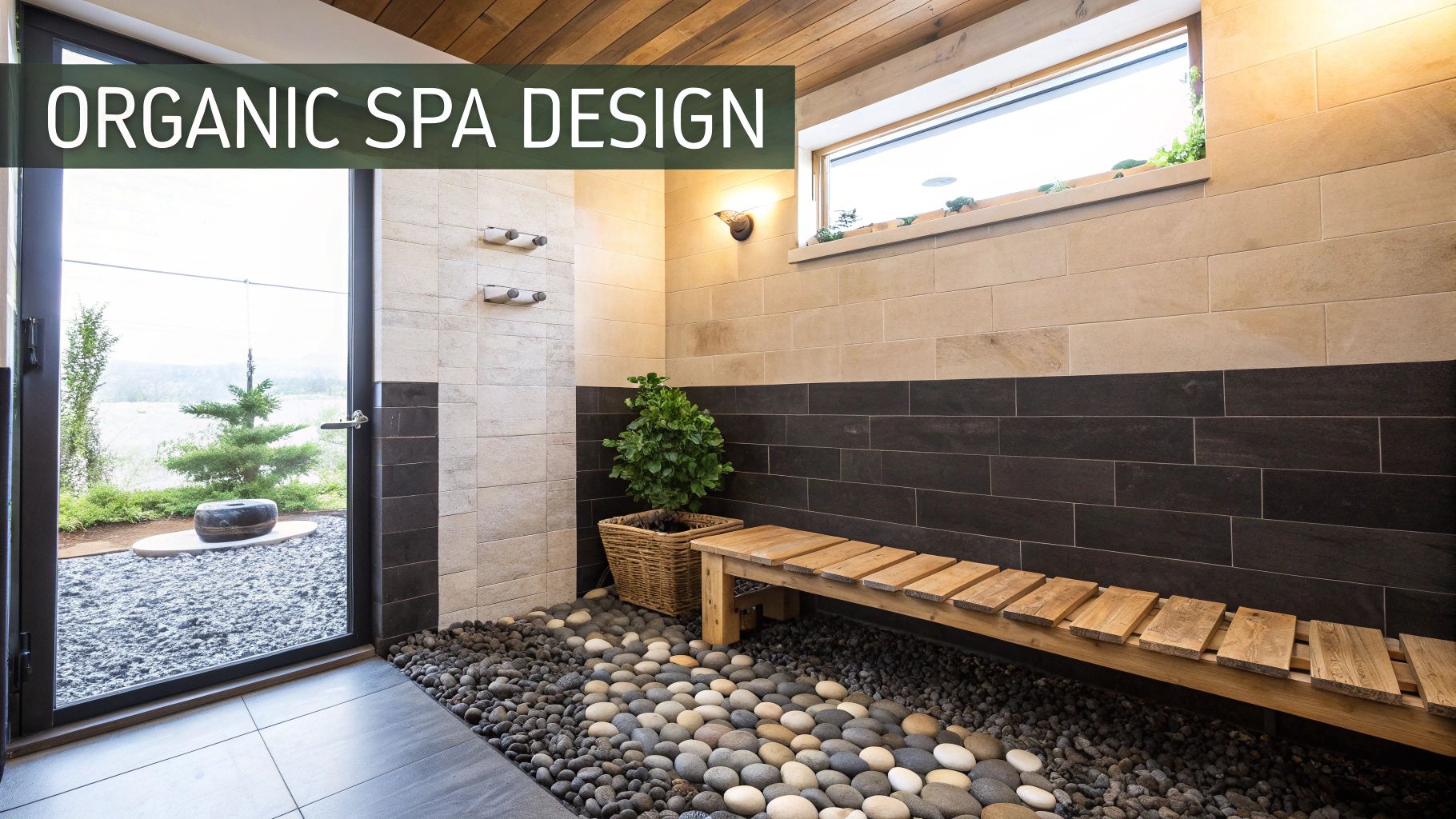
This upgrade is one of the most effective spa ideas for bathroom enhancements because it provides a form of invisible, silent comfort that elevates the entire space. Modern systems integrate smart thermostats, allowing you to program heating schedules, control temperatures remotely via a smartphone app, and monitor energy usage. As noted by the U.S. Department of Energy, radiant heating can be more efficient than traditional forced-air systems because it eliminates heat loss through ducts. This consistent, gentle warmth contributes directly to a tranquil, high-end experience reminiscent of Scandinavian spa culture and luxury hotels.
How to Implement Radiant Floor Heating
Integrating this feature is most cost-effective during a renovation or new construction when the subfloor is exposed. The process involves laying down electric heating mats or hydronic tubing before installing the final flooring material like tile, stone, or luxury vinyl. It is crucial to choose a system compatible with your flooring choice and overall bathroom design. The comfort it provides is a daily luxury, making your bathroom a true sanctuary.
Pro-Tip: Proper subfloor insulation is critical for maximizing the efficiency of your radiant heating system. Without it, a significant amount of heat can be lost downwards. The Radiant Professionals Alliance emphasizes that insulation can reduce heat loss by over 50%, ensuring the warmth radiates up into your room where you want it.
Key Considerations for Installation
To achieve a perfectly warm and efficient floor, keep these actionable tips in mind:
- Choose the Right System: Electric mat systems are generally easier and less expensive to install in a single-room renovation, while hydronic (hot water) systems are often more efficient for whole-house heating.
- Invest in a Smart Thermostat: A programmable or smart thermostat is essential for energy efficiency. It allows you to heat the floor only when needed, such as in the morning before you wake up, reducing operational costs.
- Ensure Correct Installation: Professional installation is highly recommended to ensure the system is laid out correctly, wired safely, and connected properly to the thermostat. Incorrect installation can create cold spots or pose safety risks.
- Plan for Floor Height: The heating system will add a small amount of height to your floor (typically less than half an inch). This must be factored into transitions to adjacent rooms and the height of the toilet flange and vanity.
4. Embrace Nature with Stone and Wood Elements
A core principle of spa design is fostering a connection with the natural world, and there is no better way to achieve this than by incorporating organic materials. Using natural stone, reclaimed wood, bamboo, and river rocks grounds the space, creating an earthy, serene atmosphere. This design philosophy moves beyond sterile, clinical aesthetics to build a calming environment that feels both luxurious and elemental, reminiscent of tranquil destination spas found in nature.
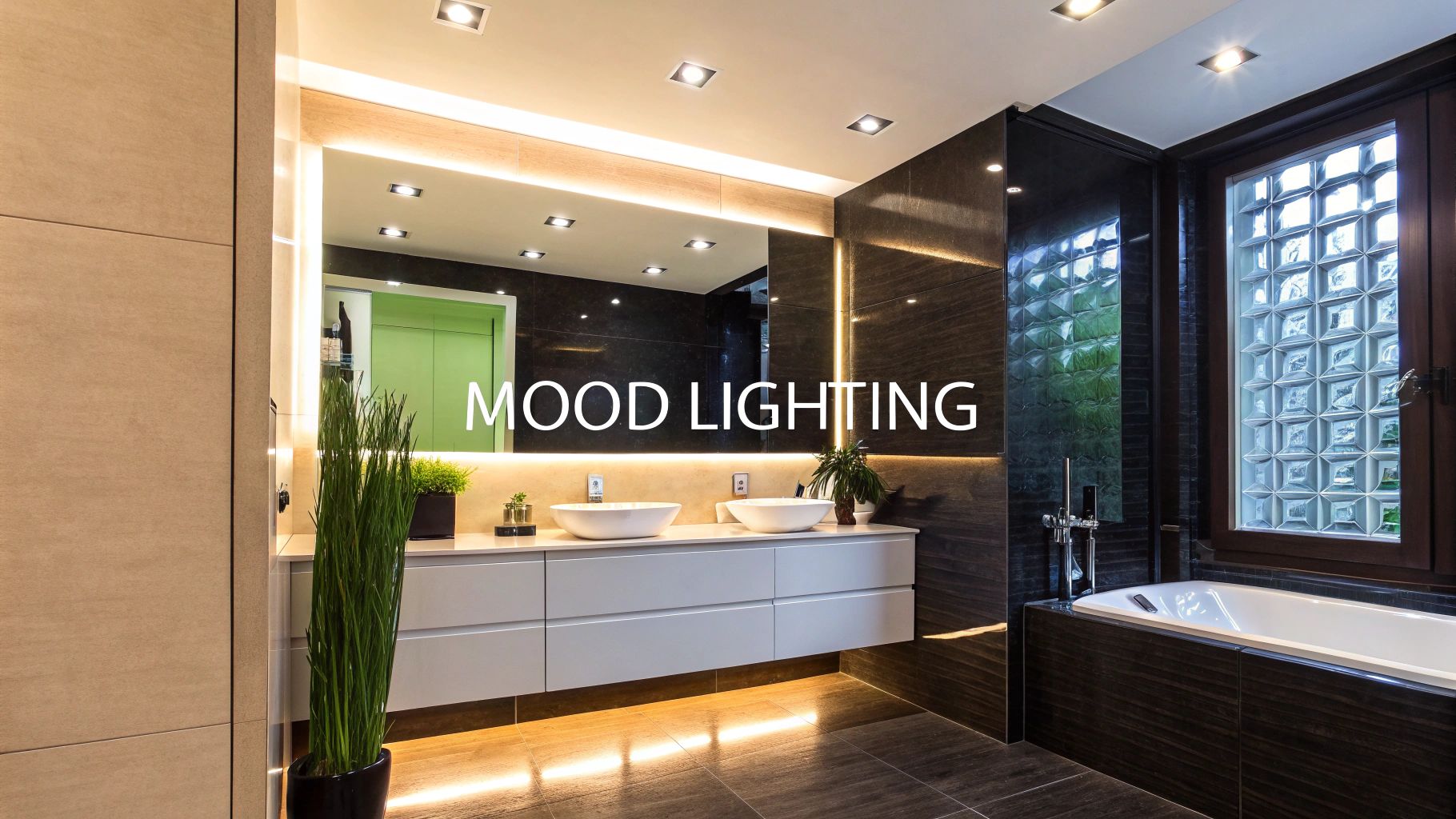
This approach is one of the most effective spa ideas for bathroom transformations because it engages our innate biophilic desire to connect with nature. The varied textures of travertine tile, the warmth of a teak shower bench, or the smooth coolness of a river rock floor all contribute to a multi-sensory experience. Design philosophies like Japanese onsen culture and Scandinavian hygge heavily influence this trend, emphasizing simplicity, authenticity, and well-being. This focus on natural materials is a key element in emerging bathroom design trends.
How to Implement Natural Materials
Successfully integrating these elements requires balancing aesthetics with practicality, especially in a wet environment. The goal is to create a cohesive palette that feels intentional and calming. For instance, pairing the elegant veining of Carrara marble with the clean lines of a bamboo vanity creates a look of sophisticated serenity. When selecting materials, consider exploring options from manufacturers known for quality stone and engineered surfaces, as they offer a wide range of durable and beautiful choices.
Pro-Tip: Don't limit wood to just vanities and accents. A slatted teak or cedar mat inside the shower provides a warm, comfortable, and naturally water-resistant surface underfoot, elevating the tactile experience of your daily routine.
Key Considerations for Installation
To ensure your natural materials remain beautiful and functional for years to come, proper selection and maintenance are paramount. Keep these actionable tips in mind:
- Seal Porous Stone: Natural stone like marble, travertine, and slate is porous and can stain. Apply a high-quality penetrating sealer upon installation and reapply every 1-2 years, as recommended by the Natural Stone Institute.
- Choose Appropriate Wood Finishes: For wood used in wet areas like shower benches or vanity tops, select naturally water-resistant species like teak, cedar, or ipe. Treat them with a marine-grade varnish or oil to prevent water damage and mildew.
- Ensure Proper Ventilation: Organic materials are more susceptible to mold and mildew in humid conditions. A high-CFM (cubic feet per minute) exhaust fan is essential to quickly remove moisture from the air.
- Mix Textures for Interest: Combine smooth, polished surfaces with rough, natural ones to add depth. For example, pair a honed stone countertop with a live-edge wood shelf or a polished marble wall with a pebble shower floor.
5. Ambient Lighting with Dimmers and Color Therapy
Lighting is a powerful yet often overlooked element that fundamentally shapes the atmosphere of a space. For a true spa-like feel, a single, harsh overhead light is insufficient. A sophisticated, layered lighting system using dimmers and color therapy transforms your bathroom from a purely functional room into a sanctuary for relaxation and mood enhancement. The goal is to create a flexible environment that can be bright and energizing for the morning or soft and tranquil for an evening soak.
This approach is one of the most effective spa ideas for bathroom transformations because it directly influences your psychological state. By layering different light sources and having full control over their intensity and color, you can tailor the ambiance to your exact needs. This concept, known as human-centric lighting, is gaining traction in wellness design. The American Lighting Association emphasizes that a layered lighting plan, combining ambient, task, and accent lighting, is key to creating both a functional and beautiful space.
How to Implement a Layered Lighting Scheme
Creating a dynamic lighting environment requires planning beyond a central fixture. It involves integrating multiple light sources that serve different purposes, all controlled by smart dimmers. Brands specializing in smart home integration offer systems that make it easy to control circuits, set scenes, and even automate lighting to align with your daily routine. Combining backlit mirrors, dimmable recessed lights, and even a led shower head system can create a comprehensive wellness experience.
Pro-Tip: Install all lighting fixtures on separate dimmer switches. This granular control is the secret to a truly versatile and spa-like atmosphere, allowing you to adjust the vanity lights, overhead lights, and accent lights independently to create the perfect mood.
Key Considerations for Installation
To achieve a professional and effective lighting design, consider these actionable tips:
- Layer Your Light Sources: Combine at least three types of light: general ambient (recessed ceiling lights), focused task (vanity sconces or backlit mirror), and subtle accent (LED strips under a floating vanity or in a niche).
- Choose the Right Color Temperature: For relaxation, use warm white bulbs (2700K-3000K). For task lighting around the mirror, a more neutral white (3500K-4000K) is ideal for accurate color rendering.
- Integrate Chromotherapy: Extend color therapy into the shower itself. An advanced shower system with integrated chromotherapy can cycle through colors to calm or invigorate you. Explore how a chromotherapy rain head can add this therapeutic layer to your daily routine.
- Ensure Wet-Rated Fixtures: Any lighting installed inside a shower or near a tub must be UL-listed as "wet-rated" for safety. This is a non-negotiable requirement mandated by the National Electrical Code (NEC).
6. Built-in Meditation and Relaxation Nook
A truly holistic home spa extends beyond water therapy to include spaces for mental and emotional rest. Carving out a dedicated area for quiet contemplation transforms the bathroom from a purely functional room into a sanctuary for mind and body. This involves creating a built-in nook, such as a window seat or a minimalist bench, designed specifically for meditation, reading, or simply unwinding in a tranquil environment. The goal is to design a space that intentionally separates you from the hustle of daily life, offering a quiet corner to decompress and recenter.
This concept is one of the more profound spa ideas for bathroom design because it addresses mental wellness directly. Luxury wellness retreats and spas inspired by Japanese and Scandinavian design principles have long incorporated these "pause points" into their layouts. The National Center for Complementary and Integrative Health reports that regular meditation can help manage anxiety and stress, making a dedicated space a powerful tool for well-being. By integrating this feature, you elevate your bathroom into a personal wellness retreat.
How to Implement a Relaxation Nook
Creating this serene space requires thoughtful integration into your bathroom's layout, whether during a remodel or as a new addition. It’s about more than just adding a chair; it's about building an intentional zone of peace. Even smaller bathrooms can incorporate this concept through clever design, turning an unused corner or alcove into a functional retreat. For more ideas on maximizing limited square footage, explore these smart ideas for a small bathroom remodel.
Pro-Tip: Beyond the visual and auditory elements, the quality of the air you breathe significantly impacts your sense of well-being. To truly complete your dedicated relaxation nook, consider integrating advanced air purification systems to ensure the environment is as clean and restorative as possible.
Key Considerations for Installation
To create a nook that is both beautiful and functional, pay close attention to materials, placement, and ambiance:
- Position Near Natural Light: If possible, locate your nook near a window. Natural light has proven benefits for mood and circadian rhythm, enhancing the restorative quality of the space.
- Use Moisture-Resistant Materials: Choose materials that can withstand the bathroom's humidity. Marine-grade wood, sealed concrete, or performance fabrics for cushions are excellent choices to prevent mold and mildew.
- Keep the Design Minimalist: A clutter-free design is essential for a relaxing atmosphere. Opt for clean lines, simple built-in storage for towels or books, and a neutral, calming color palette.
- Incorporate Soft, Dimmable Lighting: Install layered lighting, such as a soft overhead fixture or a small reading sconce with a dimmer. This allows you to adjust the ambiance to suit your activity, whether it's bright for reading or low for meditation.
7. Premium Sound System with Water-Resistant Speakers
Sound is a powerful yet often overlooked element in creating a truly immersive spa atmosphere. Integrating a premium sound system with water-resistant speakers elevates your bathroom from a functional space to an auditory sanctuary. This technology allows you to stream calming music, guided meditations, or ambient nature sounds directly into your relaxation zone, masking external noise and deepening your sense of tranquility. The goal is to engage the sense of hearing to complement the physical sensations of a spa experience.
This is one of the most versatile spa ideas for bathroom upgrades because it can be achieved at various price points and levels of integration. The therapeutic use of sound, or sound bathing, is recognized for its ability to lower stress and promote mindfulness, a concept explored by institutions like the Integrative Health Matters. Some innovative fixtures even combine audio with other sensory elements. For example, an advanced led shower head system can integrate a Bluetooth speaker, allowing you to enjoy a symphony of light, water, and sound all at once for a complete multi-sensory escape.
How to Implement a Bathroom Sound System
Integrating audio into a wet environment requires specialized equipment designed to withstand moisture and humidity. The simplest approach is a high-quality portable waterproof speaker, while a more seamless solution involves installing architectural speakers built directly into the walls or ceiling. For the ultimate fusion of hydrotherapy and audio, consider a fixture with built-in sound capabilities. You can explore a shower head with an integrated Bluetooth speaker from brands like CRANACH to deliver high-quality audio directly within the shower enclosure.
Pro-Tip: Pay close attention to a speaker's Ingress Protection (IP) rating. A rating of IPX4 is splash-proof, suitable for general bathroom use, while IPX7 is fully waterproof and can be submerged, making it ideal for placement inside a shower or near a tub. The National Electrical Manufacturers Association (NEMA) provides standards that help define these enclosure protection levels.
Key Considerations for Installation
To ensure your audio system provides crisp, clear sound safely and effectively, follow these actionable tips:
- Verify the IP Rating: Choose a speaker with a rating appropriate for its specific location. A speaker on a vanity needs less protection than one installed directly in a shower zone.
- Plan Speaker Placement: For built-in systems, position speakers to provide balanced sound coverage. Avoid placing them where they will be in the direct, constant path of a shower spray to maximize longevity.
- Test Connectivity: Before permanently installing any Bluetooth or wireless speakers, test the signal strength and reliability from where you'll typically be controlling the audio.
- Curate Your Content: Create dedicated playlists for different moods. Have a library of calming ambient sounds, gentle classical music, or guided meditation tracks ready to enhance your spa sessions.
Spa Bathroom Ideas Comparison Guide
| Feature / Item | Implementation Complexity 🔄 | Resource Requirements ⚡ | Expected Outcomes 📊 | Ideal Use Cases 💡 | Key Advantages ⭐ |
|---|---|---|---|---|---|
| Rain Shower System with Multiple Shower Heads | High – plumbing & possible electrical work | High water flow, upgraded water heater, pro install | Spa-like hydrotherapy, luxury bathroom upgrade | Luxury home bathrooms, spa enthusiasts | Immersive spa experience, multiple water options, adds home value |
| Freestanding Soaking Tub with Aromatherapy Features | Moderate – floor prep and space needed | Significant floor space, possible floor reinforcement | Deep relaxation, bathroom centerpiece | Spacious bathrooms focused on self-care | Dramatic focal point, ergonomic comfort, aromatherapy benefits |
| Heated Floors with Smart Temperature Control | Moderate-High – best during renovation | Electrical/hydronic installation, smart controls | Consistent warmth, energy efficient heating | Bathrooms with tile/stone floors, remodel projects | Even heat distribution, energy savings, invisible luxury |
| Natural Stone and Wood Elements | Moderate – material installation & sealing | Varied (stone, wood), ongoing maintenance | Calming, organic spa-like environment | Natural design themes, nature-inspired spaces | Timeless appeal, connection to nature, sustainable options |
| Ambient Lighting with Dimmers and Color Therapy | Moderate – electrical work required | LED fixtures, smart controls, dimmers | Flexible ambiance, mood enhancement | All bathroom types, mood enhancement | Dramatic atmosphere, energy efficient, customizable lighting scenes |
| Built-in Meditation and Relaxation Nook | High – custom carpentry & climate control | Dedicated space, specialized materials | Dedicated mindfulness area, relaxation boost | Large bathrooms, wellness-focused homes | Promotes daily wellness, efficient use of space, unique feature |
| Premium Sound System with Water-Resistant Speakers | Low-Moderate – simple setup to professional install | Bluetooth/WiFi devices, water-resistant speakers | Enhanced relaxation with audio therapy | All bathrooms, smart home integrations | High-quality sound, wireless convenience, supports meditation/music |
Your Personal Oasis Awaits
Transforming a functional bathroom into a personal spa is no longer a luxury reserved for high-end resorts. It is an attainable and deeply rewarding investment in your daily well-being. By thoughtfully integrating the seven core spa ideas for bathroom design we have explored, you move beyond mere aesthetics. You are consciously engineering an environment dedicated to relaxation, rejuvenation, and mental clarity. This is about more than just a renovation; it's about crafting a sanctuary that actively supports your self-care rituals.
The journey to creating this personal oasis begins with understanding how each element contributes to the overall sensory experience. From the immersive cascade of a multi-function shower to the grounding warmth of heated floors, every choice plays a crucial role in shaping the atmosphere of tranquility.
Recapping the Pillars of Your At-Home Spa
Let’s revisit the key takeaways that form the foundation of a truly restorative bathroom design:
- Elevate Your Showering Ritual: A standard fixture simply cleanses, but a multi-head rain shower system creates a therapeutic, full-body experience. The addition of a CRANACH led shower head system introduces chromotherapy, using light to influence mood and enhance relaxation. This transforms a daily routine into a mindful moment of escape.
- Embrace Deep Soaking: The transition from a standard built-in tub to a freestanding soaking tub marks a significant shift in purpose. It becomes a destination for intentional relaxation, especially when paired with aromatherapy features that engage the sense of smell to calm the mind and body.
- Build Comfort from the Ground Up: The simple act of stepping onto a warm surface sets a tone of comfort and luxury. Heated flooring is a foundational element that provides consistent, gentle warmth, making the space feel welcoming and eliminating the cold shock of traditional tile.
- Connect with Nature: The strategic use of natural stone and wood does more than add visual appeal. These materials create a tactile, organic connection to the outdoors, promoting a sense of calm and grounding, as confirmed by principles of biophilic design discussed by experts at Architectural Digest.
- Master the Mood with Light and Sound: A single, harsh overhead light is the enemy of a spa-like atmosphere. A layered ambient lighting scheme with dimmers allows you to tailor the environment to your needs, while an integrated, water-resistant sound system lets you curate the perfect auditory backdrop for your escape.
Your Actionable Path to a Personal Sanctuary
Creating your dream spa bathroom is a process of deliberate choices. The goal is not necessarily to implement every single idea at once, but to identify which elements will have the most significant impact on your personal well-being.
Start by assessing your current space and your daily routines.
- Identify Your Priority: Which element would change your daily experience the most? Is it the morning rush, which could be transformed by an invigorating shower system? Or is it the need for a quiet evening escape, where a deep soaking tub would be invaluable?
- Plan in Phases: If a full renovation is not feasible, consider a phased approach. Upgrading your shower head to a led shower head system is a manageable first step that delivers an immediate sensory upgrade. You can plan for heated floors or a new tub in a future phase.
- Consult with Professionals: For complex installations involving plumbing and electrical work, such as installing a new shower system or heated floors, consulting with a qualified contractor or designer is essential. They can provide valuable insights on layout, material suitability, and ensuring everything is up to code. You can find certified professionals through organizations like the National Kitchen & Bath Association (NKKA).
Ultimately, the most successful spa bathroom is one that is tailored to you. It reflects your personal definition of relaxation and is designed to seamlessly integrate into your life. By investing in these foundational spa ideas for bathroom design, you are not just increasing your home’s value; you are making a profound investment in your own health and happiness. Your personal oasis is within reach, waiting to be created.
Ready to take the first step in building your dream bathroom? Explore the premium collections at Cranach bath and kitchen. We specialize in high-quality fixtures, including advanced led shower head system packages and elegant soaking tubs, designed to bring the luxury spa experience directly into your home. Discover the Cranach bath and kitchen difference today and start crafting your personal sanctuary.

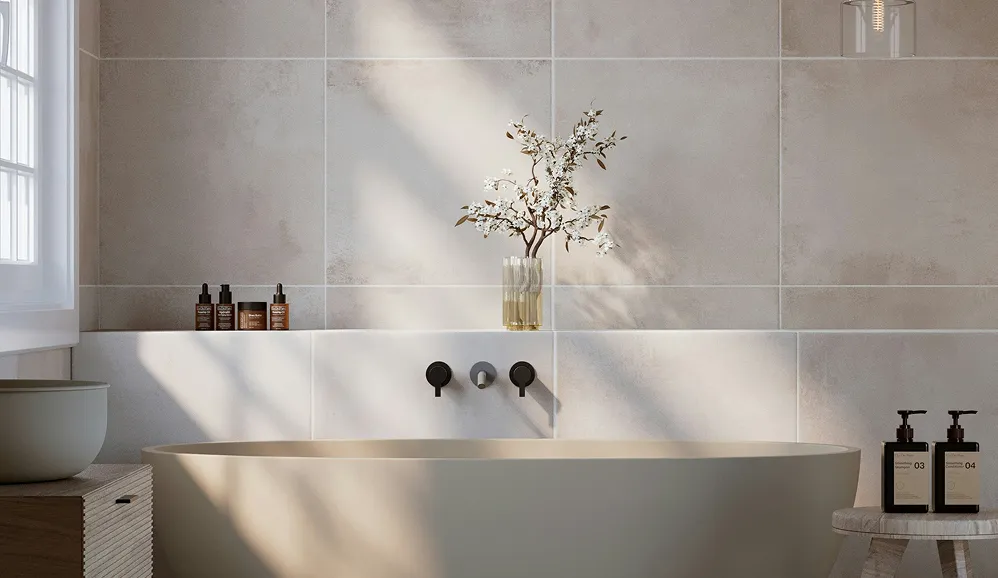
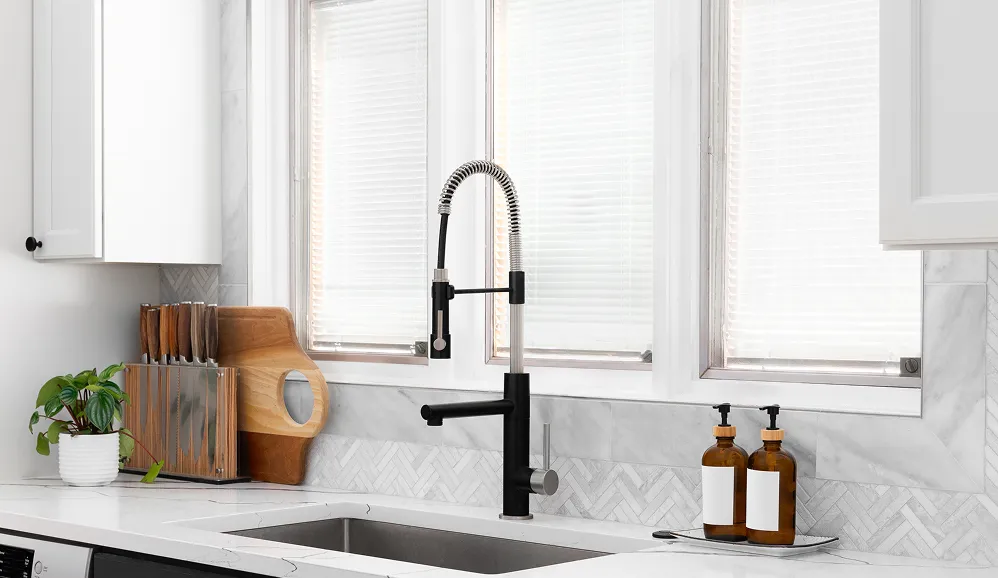
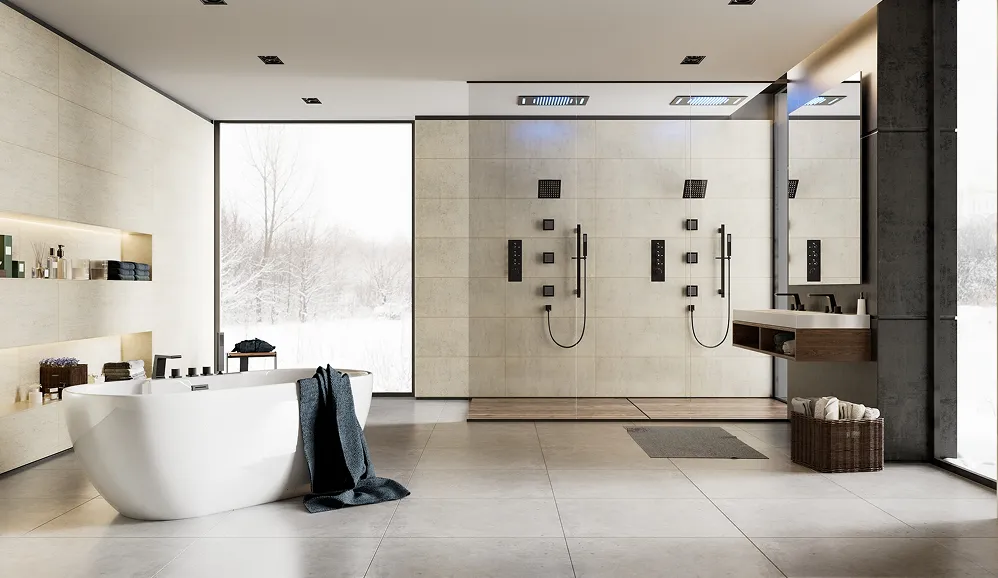
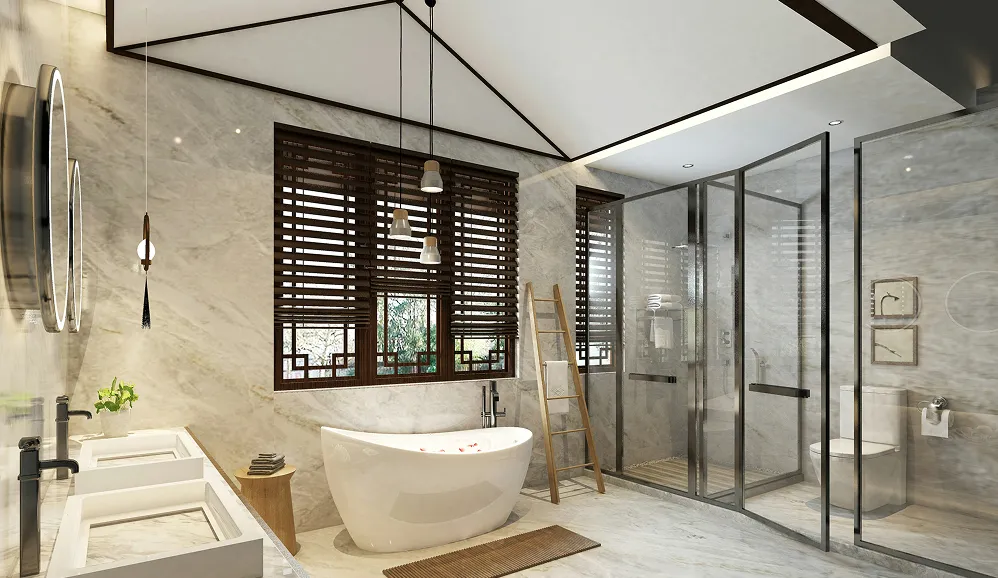
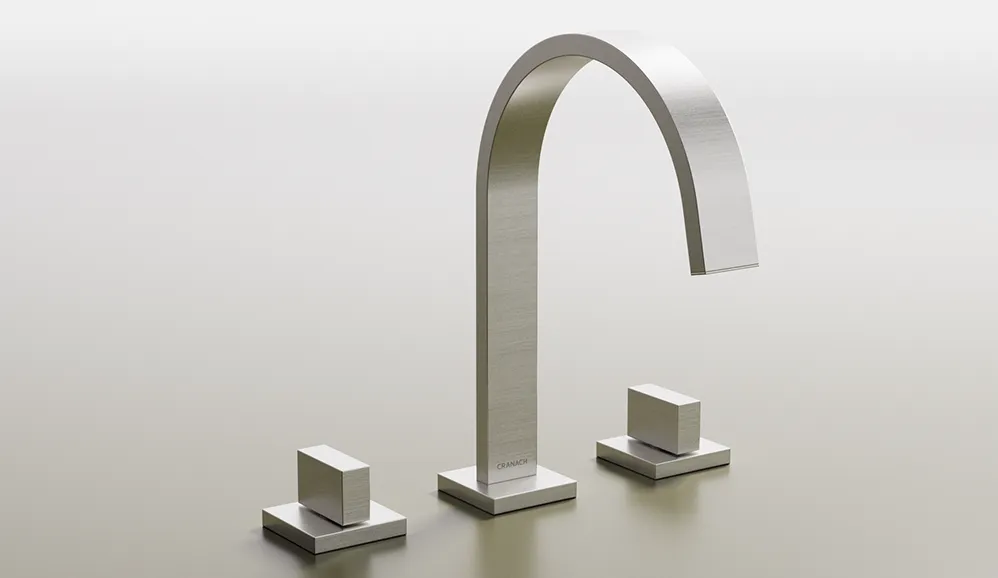
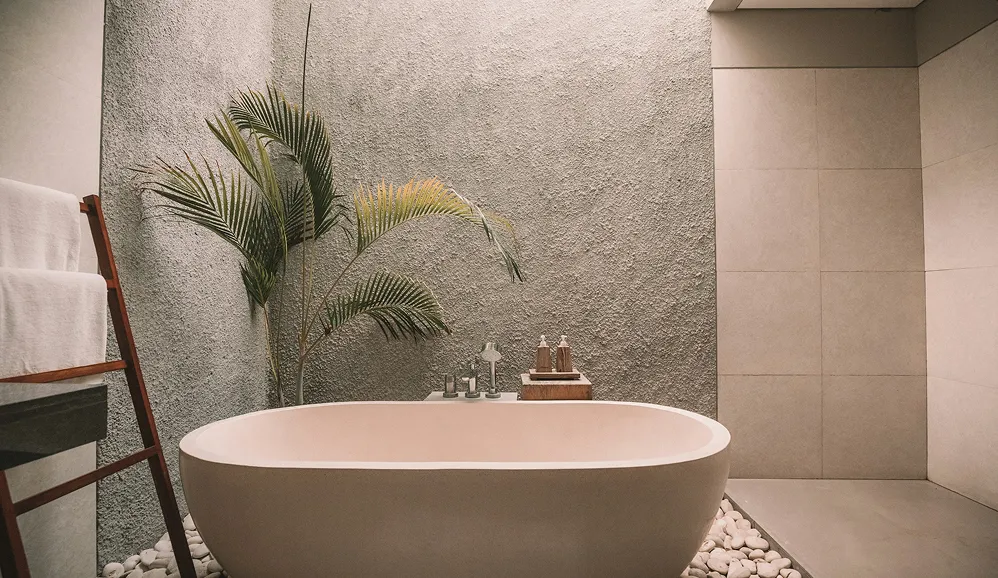
Leave a Reply